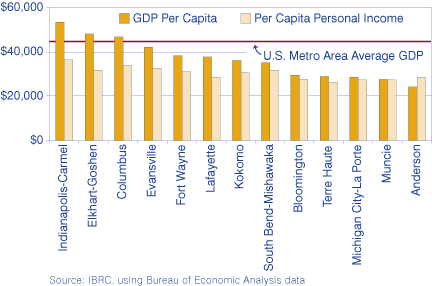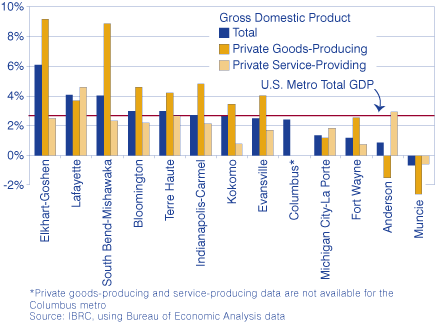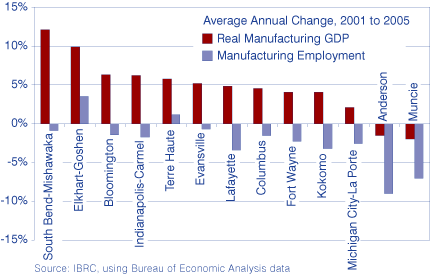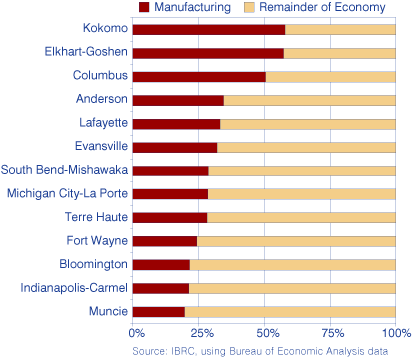Gross Domestic Product by Metropolitan Area
A recent release by the U.S. Bureau of Economic Analysis (BEA) provides new insights into the nature of Indiana's local economies. In September 2007, BEA introduced the gross domestic product (GDP) by metropolitan area estimates covering 2001 to 2005. GDP, which is widely considered the most comprehensive measure of total economic activity, tracks the market value of final goods and services produced within a given area.
Unfortunately, due to the nature of metropolitan areas, we are not able to get a complete picture of metropolitan economic activity in Indiana. For instance, Lake County, the state's second largest county, is considered part of the Chicago metro. In the southern portion of the state, the Louisville and Cincinnati metro areas include Indiana counties as well.
Not surprisingly, the 10-county Indianapolis-Carmel metro dominates the state in terms of total economic activity. As Table 1 shows, the Indianapolis metro's nearly $88 billion in output in 2005 accounted for 37 percent of the state total. Put another way, the Indianapolis-Carmel area is responsible for $1 of each $2.70 produced in Indiana. Indianapolis ranked as the 30th largest metro in the nation.
Table 1: Gross Domestic Product, 2005
| Metropolitan Area | Metro GDP (Current Dollars, in Millions) |
Percent of Indiana GDP (Current Dollars) |
Average Annual Change Real GDP Since 2001 |
Per Capita GDP |
|
| Current Dollars |
National Rank (out of 363) |
||||
| Indianapolis-Carmel | $87,645 | 37.1% | 2.7% | $53,441 | 24 |
| Fort Wayne | $15,512 | 6.6% | 1.2% | $38,379 | 131 |
| Evansville* | $14,666 | 6.2% | 2.5% | $42,012 | 92 |
| South Bend–Mishawaka# | $11,176 | 4.7% | 4.0% | $35,192 | 178 |
| Elkhart-Goshen | $9,391 | 4.0% | 6.1% | $48,091 | 39 |
| Lafayette | $6,930 | 2.9% | 4.1% | $37,767 | 144 |
| Bloomington | $5,253 | 2.2% | 3.0% | $29,555 | 268 |
| Terre Haute | $4,873 | 2.1% | 3.0% | $28,988 | 278 |
| Kokomo | $3,646 | 1.5% | 2.6% | $36,003 | 169 |
| Columbus | $3,439 | 1.5% | 2.4% | $46,719 | 50 |
| Anderson | $3,210 | 1.4% | 0.9% | $27,624 | 338 |
| Muncie | $3,173 | 1.3% | -0.7% | $24,335 | 304 |
| Michigan City–La Porte | $3,139 | 1.3% | 1.3% | $28,464 | 289 |
| Total | $172,053 | 72.8% | 2.7% | $43,369 | |
| Chicago-Naperville-Joliet (IL-IN-WI) | $461,374 | n/a | 1.4% | $48,840 | 32 |
| Cincinnati-Middletown (OH-KY-IN) | $90,963 | n/a | 2.1% | $43,503 | 78 |
| Louisville-Jefferson County (KY-IN) | $50,108 | n/a | 1.4% | $41,405 | 97 |
#Includes Cass County in Michigan
Source: IBRC, using Bureau of Economic Analysis data
The Fort Wayne, Evansville and South Bend–Mishawaka metro areas are other top producers with total output exceeding $10 billion. In most cases, a metro's share of state GDP is roughly analogous to its share of total population. One exception is Indianapolis, whose 37.1 percent share of total GDP far exceeds its 26 percent share of total population.
Per Capita GDP
A better way to compare areas of differing size is to analyze GDP per capita (see Figure 1). Indianapolis-Carmel led the state with a GDP per capita of $53,441 in 2005 and is followed closely by Elkhart-Goshen ($48,091) and Columbus ($46,719). These three communities exceed the national metro average and rank in the top 50 of 363 metros nationwide in GDP per capita. In total, eight of Indiana's 13 metros rank in the top half nationally, which is impressive given Indiana's relatively low cost of living.
Figure 1: Per Capita GDP and Personal Income (Current Dollars), 2005

It is important to note that per capita GDP differs from per capita personal income in that it includes corporate income and excludes government transfer payments. If a particular community has experienced significant investment by outside companies, a portion of total output will leave the community in the form of corporate profits. As Figure 1 illustrates, this is the case in many of the state's metro areas. Therefore, personal income is likely a better measure of general standard of living than is per capita GDP.
Change in GDP, 2001–2005
Nearly all of Indiana's metro areas have experienced growth in real GDP from 2001 to 2005. Only Muncie has seen a downturn. Figure 2 highlights the average annual growth in total real GDP as well as in two broadly defined sectors: private goods-producing industries and private service-providing industries. Together, these sectors account for all non-government output. Goods-producing industries cover manufacturing, construction, agriculture and natural resources; services-providing industries include all trade and service-related activity. Production remains the economic catalyst in Indiana. Growth in goods-producing industries outpaced services in all but four Indiana metros: Lafayette, Michigan City-La Porte, Anderson and Muncie. Of all areas with annual growth rates above 1.5 percent, only Lafayette is spurred more by service activities.
Figure 2: Average Annual Change in Real GDP, 2001 to 2005

Nine of the state's 13 metros can boast an annual growth rate of greater than 2 percent over this period. Furthermore, nearly half of the state's metros exceed the national metro area growth rate. Of all Indiana metros, though, Elkhart-Goshen is a true success story. Its 6.1 percent annual growth rate over this period ranks 28th nationally. This figure is more impressive considering that, with the exception of Ocean City, N.J., all higher-ranking metros are located in the generally high-growth Sun Belt or Pacific Northwest regions. Elkhart-Goshen's position in the RV industry is the primary driver of growth.
Manufacturing is Still King
The growth of real GDP in goods-producing industries seems at odds with the much discussed reality that Indiana is losing manufacturing jobs. How can Indiana increase manufacturing output while decreasing employment? The answer lies in increased productivity. Figure 3 compares the average annual change in manufacturing output to the average annual change of manufacturing employment. All but two metros have seen an increase in manufacturing GDP, yet only two areas have seen an increase in manufacturing employment. The South Bend–Mishawaka metro, for instance, has experienced a 12 percent annual increase in manufacturing output from 2001 to 2005 while losing employment.
Figure 3: Average Annual Change in Real Manufacturing GDP and Manufacturing Employment, 2001 to 2005

Manufacturing continues to drive the Indiana economy (see Figure 4). Manufacturing is the largest industry in terms of output in each of the state's metro areas with the exception of the Bloomington metro, where the government sector (largely Indiana University) edges out manufacturing, 21.8 percent to 21.6 percent. Moving forward, it is important that Indiana maintain its position as a national leader in manufacturing while expanding opportunities in other targeted industries.
Figure 4: Manufacturing GDP as a Share of Total GDP, 2005

Matt Kinghorn, Economic Research Analyst
Indiana Business Research Center, Kelley School of Business, Indiana University
